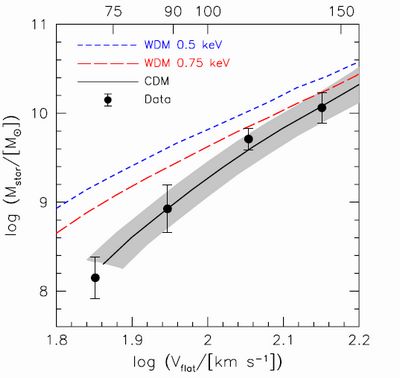Prof. Xi Kang leading team from Max-Planck-Institute Partner Group (MPG) of the Purple Mountain Observatory(PMO) of the Chinese Academy of Sciences (CAS) recently find it feasible to put constraints on the mass of a possible warm dark matter (WDM) component by investigating the observable properties of galaxies. Instead of the traditional DM mass constraints from studying the Lyα galaxies in the early universe, this study provides an alternative way to learn the nature of DM candidates. The paper appears in the Astrophysical Journal(2013, 767,22).
By combining high-resolution N-body simulations with a semi-analytical model of galaxy formation, our researchers (Kang, Maccio and Dutton) compare three WDM models with a dark matter (DM) mass of 0.5, 0.75, and 2.0 keV with the standard cold dark matter case. For a fixed set of parameters describing the baryonic physics, the WDM models predict fewer galaxies at low (stellar) masses, as expected due to the suppression of power on small scales, while no substantial difference is found at the high-mass end (see figure 4). However, these differences in the stellar mass function vanish when a different set of parameters is used to describe the (largely unknown) galaxy formation processes. The authors show that it is possible to break this degeneracy between DM properties and the parameterization of baryonic physics by combining observations on the stellar mass function with the Tully–Fisher relation (the relation between stellar mass and the rotation velocity at large galactic radii as probed by resolved Hi rotation curves). WDM models with a too warm candidate (mν < 0.75 keV) cannot simultaneously reproduce the stellar mass function and the Tully–Fisher relation(figure 5). This result strongly supports the Cold Dark Matter(CDM) model. And they finally conclude that accurate measurements of the galaxy stellar mass function and the link between galaxies and DM halos down to the very low mass end can give very tight constraints on the nature of DM candidates.

Tully–Fisher relation. The lines show the same models as in Figures 3 and 4. For the models, we calculate Vflat at a radius enclosing 80% of the cold gas. The filled circles with error bars show the mean (and error on the mean) of logMstar in bins of Vflat using observations from Stark et al. (2009) and McGaugh (2012). The shaded region shows the effect of halo contraction and expansion. The CDM model is clearly favored over both WDM models.
This work for the first time points out that people can constrain the DM candidates by statistically studying the observable properties of galaxies. It is meaningful and instructional to the next generation weak lensing survey e.g. the Kunlun Dark Universe Survey Telescope on Dome-A, Antarctic. |
